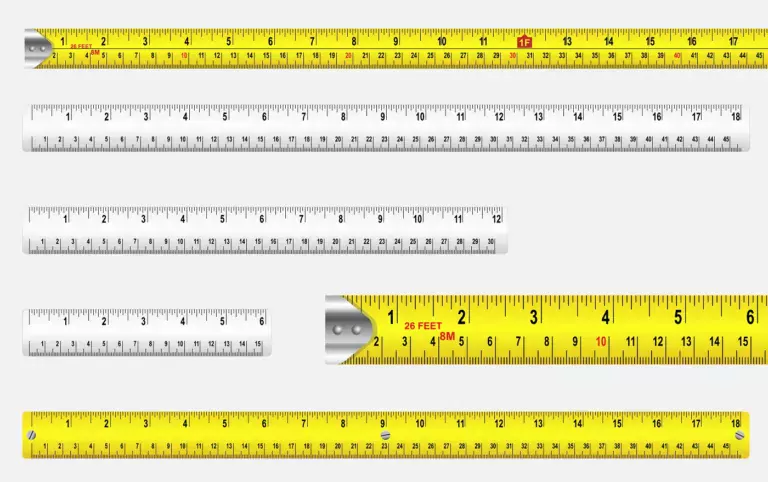Today’s topic is units of measure—those words and symbols that come after numbers.
Put a Space Between Numbers and Units of Measure
This first point may seem self-evident: you put a space between the number and the unit of measure. Even though it seems obvious, I’m telling you because I’ve seen people do it wrong, and there are also exceptions to the rule.
For example, if you want to say you threw a ball 100 feet, there is a space between the number 100 and the whole word feet. Obvious, right? But what if you use the abbreviation ft. instead of the word feet? It’s the same rule: there’s a space between 100 and ft., and if you just think of the abbreviation as the word, it should be easy to remember, but I’ve seen them squished together without a space many times.
Most style guides do recommend writing out units of measure (e.g., the word feet instead of the abbreviation ft.) unless you are writing a technical or scientific document, but abbreviations are acceptable in tables in other kinds of writing too.
Degrees and Percentages
Sometimes I think people get confused because there are a few exceptions to that rule—percent, degrees, and foot and inch symbols—but it helps to remember that these exceptions occur when you are using symbols instead of abbreviations. For example, if you are writing out the words 100 degrees, there is a space between the number 100 and the word degrees, but if you are using the degree symbol, that little superscript circle, you butt it right up against the number without any spaces in between (100°—no space). The same holds true if you want to use the percent sign. Even though you use a space when you are writing out the word percent, if you use the percent sign, it goes right after the number without any spaces (100%—no space). It’s the same for the foot and inch symbols (those little prime and double prime marks). If you write four feet five inches with symbols (4’5’’), it’s written all together.
Units of Measure in Compound Modifiers
For the next point, let’s go back to talking about feet. The singular is obviously foot, and the plural is usually feet, but when you are using it as a compound modifier, you use the singular. For example, you would say that Squiggly climbed a tree that was 10 feet tall.* But you don’t say Squiggly ran up a 10-feet tree—you say Squiggly ran up a 10-foot tree. I don’t have a good explanation for why—that’s just the way it is. (If you know why, please leave a comment!) That’s also true for other units of measure such as inches and pounds. Squiggly was running from a 100-pound monster, and he was terrified of its 10-inch tentacles.
Similarly, the abbreviations for units of measure are the same whether the units are singular or plural. The abbreviation is ft. whether it is foot or feet. Occasionally you will see an s after the abbreviation for pounds, lbs. For example, the AP Stylebook notes that lbs. is sometimes used in sports such as weightlifting, (1) but in most cases, the s isn’t necessary.
Should You Put a Period After Abbreviations?
Although it’s technically a style choice, most US style guides recommend putting periods after abbreviations for English units of measure such as feet, inches, and pounds. (2, 3) In general, it’s more common to use periods in the US than in Britain. (4) With the metric system, or more formally the International System of Units, you never use a period after the abbreviations. (5)
Next: Why Is Pound Abbreviated “Lb”?
Have you ever wondered why pounds is abbreviated as lb. instead of pd or something that relates to how it is actually spelled? It has to do with Latin. The abbreviation lb. stands for the Latin phrase libre pondo, which means “pound of weight.” There are some really extensive explanations on the web, so here are some links:
Grammar Girl Books Mentioned in the Podcast
|
References
- 1. “Ask the Editor.” AP Stylebook website. To know more click on this link (accessed January 28, 2014).
- 2. Lutz, G. and Stevenson, D. Grammar Desk Reference. 2005. Writer’s Digest Books. p. 324.
- 3. “Periods and Abbreviations.” The Chicago Manual of Style,16th edition. Section 10.67. Chicago University Press. To know more click on this link (accessed January 28, 2014).
- 4. Wikipedia contributors, “American and British English spelling differences,” Wikipedia, The Free Encyclopedia. To know more click this Wikipedia link (accessed August 17, 2007).
- 5. “Correct SI-metric usage” U.S. Metric Association. April 24, 1007, lamar.colostate.edu/~hillger/correct.htm (accessed August 16, 2007).
This article is a minor rewrite and rerecording of an article that first appeared August 16, 2007.
- * The Oxford Dictionary of English Usage states that foot can also be used in sentences such as this: “Squiggly climbed a tree that was 10 foot tall.” It notes that this use is correct, but less common.




